FRIEZE LA | 2023
Stand A14
30 January 2023
Head-Image
For Frieze Los Angeles 2023, Goodman Gallery spotlights three major artists: Ghada Amer, William Kentridge and Yinka Shonibare CBE RA.
The presentation follows important survey exhibitions for all three artists: Ghada Amer at MUCEM (Marseille, France); William Kentridge: In Praise of Shadows at The Broad (Los Angeles, US); Yinka Shonibare CBE: Planets in My Head at Frederik Meijer Gardens & Sculpture Park (Michigan, US).


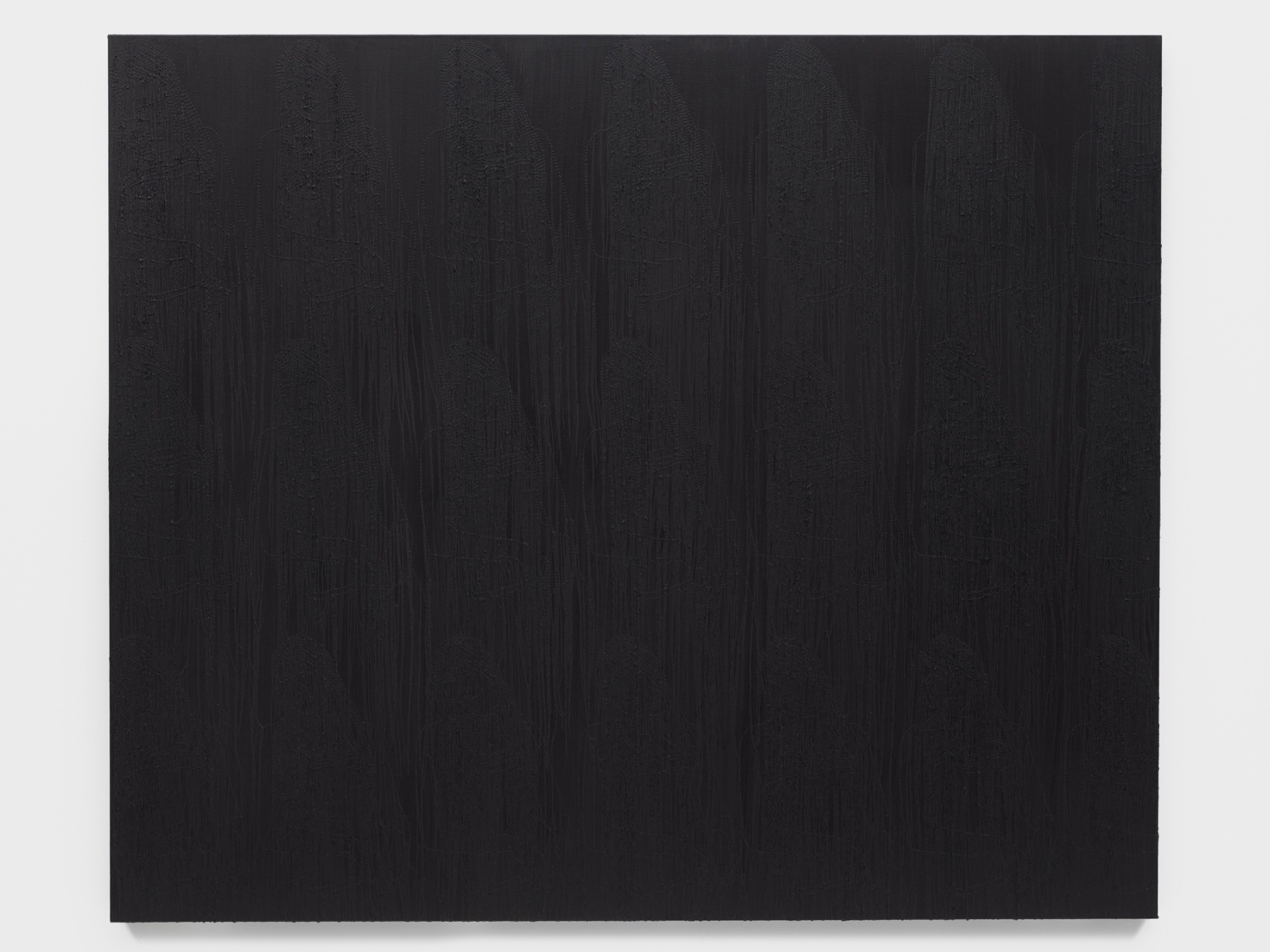
Ghada Amer
ANOTHER BLACK PAINTING, 2019
Acrylic, embroidery and gel medium on canvas
149.9 X 182.9 cm
Amer’s wide-ranging practice spans painting, cast sculpture, ceramics, works on paper, and garden and mixed-media installations. Recognising both that women are taught to model behaviors and traits shaped by others, and that art history and the history of painting in particular are shaped largely by expressions of masculinity, Amer’s work actively subverts these frameworks through both aesthetics and content. Her practice explores the complicated nature of identity as it is developed through cultural and religious norms as well as personal longings and understandings of the self. From afar Amer’s ANOTHER BLACK PAINTING (2019) reads as an abstract work rendered in rich black colour. On closer inspection, the work depicts a repeated motif of a woman’s outline in black thread stitched onto a black painted surface. The repeated figure merges with the background in certain places, then reappears elsewhere to create an important visual interplay between the abstract appearance of the canvas and its figurative elements. This invites parallels between the linearity of thread and painted brushstrokes. The effect is a visual and intellectual tension between visibility and invisibility, both of the subject depicted and the material ‘objecthood’ of the work itself. In this work, Amer points to traditions of abstraction and the canon of painting, historically dominated by men, and practices of needlework often designated as “women’s work”. ANOTHER BLACK PAINTING directs audiences to look, and look again, and question whether we can rely on vision alone.
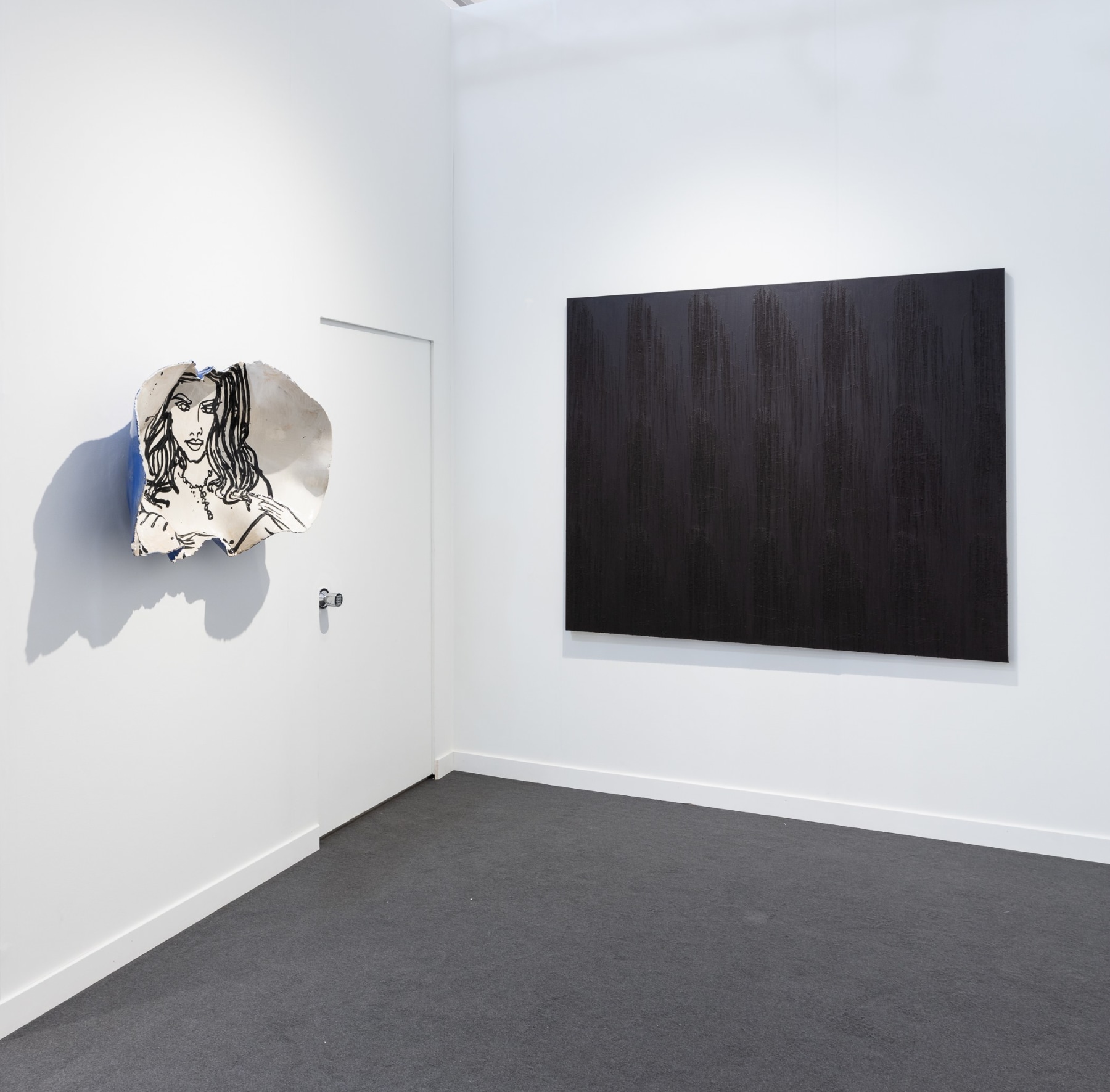



Ghada Amer
Small Leaves – RFGA, 2014
Acrylic, embroidery and gel medium on canvas
91.4 x 106.7 cm
The transgressive erotic embroideries which brought Amer to prominence in the 1990s depict forms with the delicacy of needle and thread. The choice of this subject matter, rendered using thread and acrylic paint, speak to Amer’s interest in subverting assumptions related to the roles and attributes assigned to women, rejecting both religious-driven laws that govern women’s bodies as well as second-wave feminist ideas that reject expressions of conventional femininity as an avenue to empowerment.
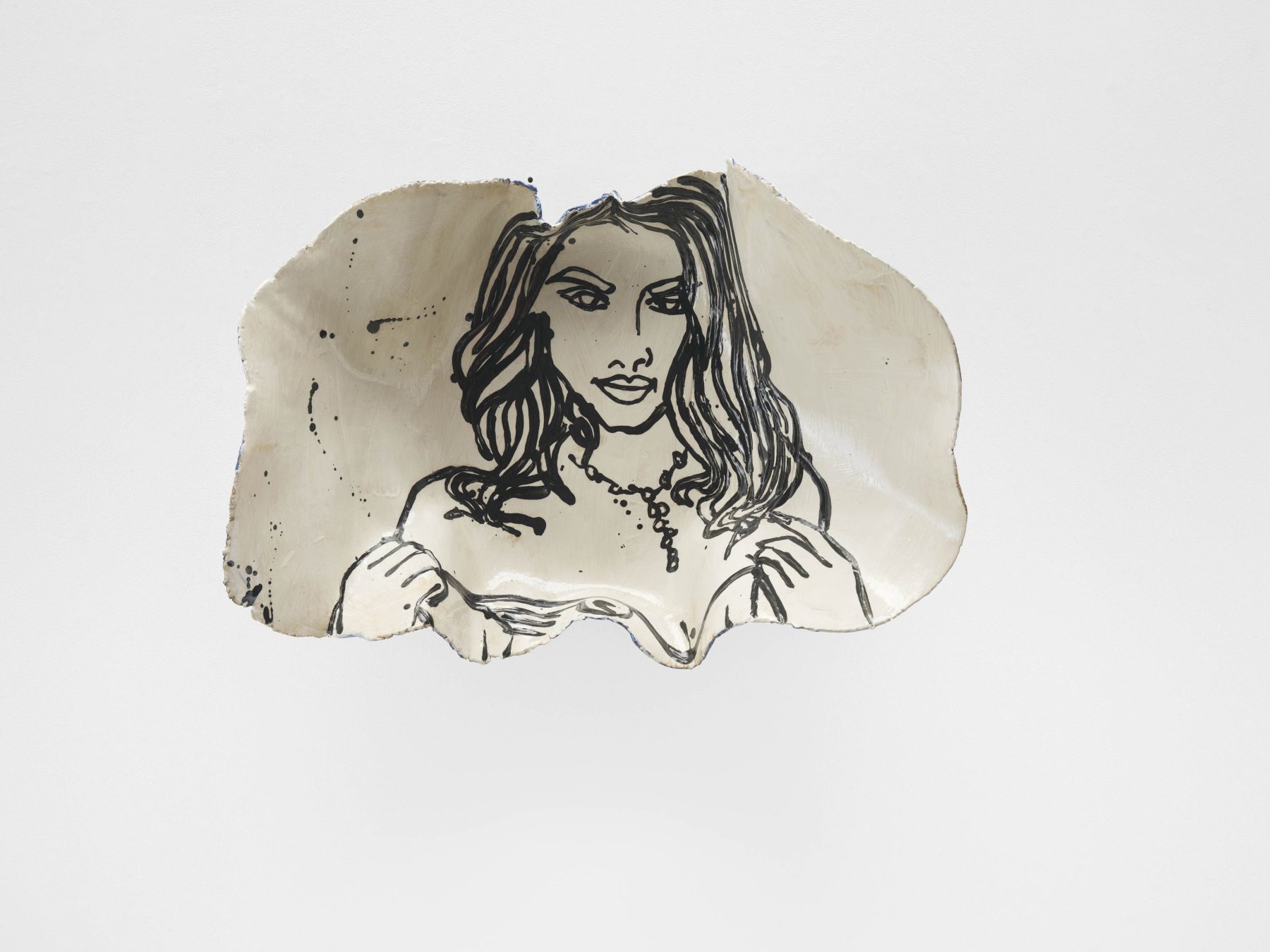
Ghada Amer
The Gypsy Girl, 2017
Glazed ceramic
64.8 x 90.2 x 31.8 cm
During a two-year residency at Greenwich House Pottery, Amer created works that are unrivalled in the worlds of both art and ceramics. “You can’t underestimate the difficulty of working with large, yet thin plates of clay”, says Adam Welch, the director of Greenwich House, referring to Amer’s work in ceramics. Ghada Amer’s portraits of women are painted in liquid clay on both sides of the thin clay plates, which she bends and manipulates until they stand upright. Amer finds her source materials in magazines, often employing motifs from erotic magazines, which she copies several times by hand in drawings, making these images her own. Amer is interested in shifting and testing the boundaries between pornography and nudity. What makes something obscene or pornographic? How does the female gaze differ from the male observer’s? How does this influence the way in which both genders view the world?
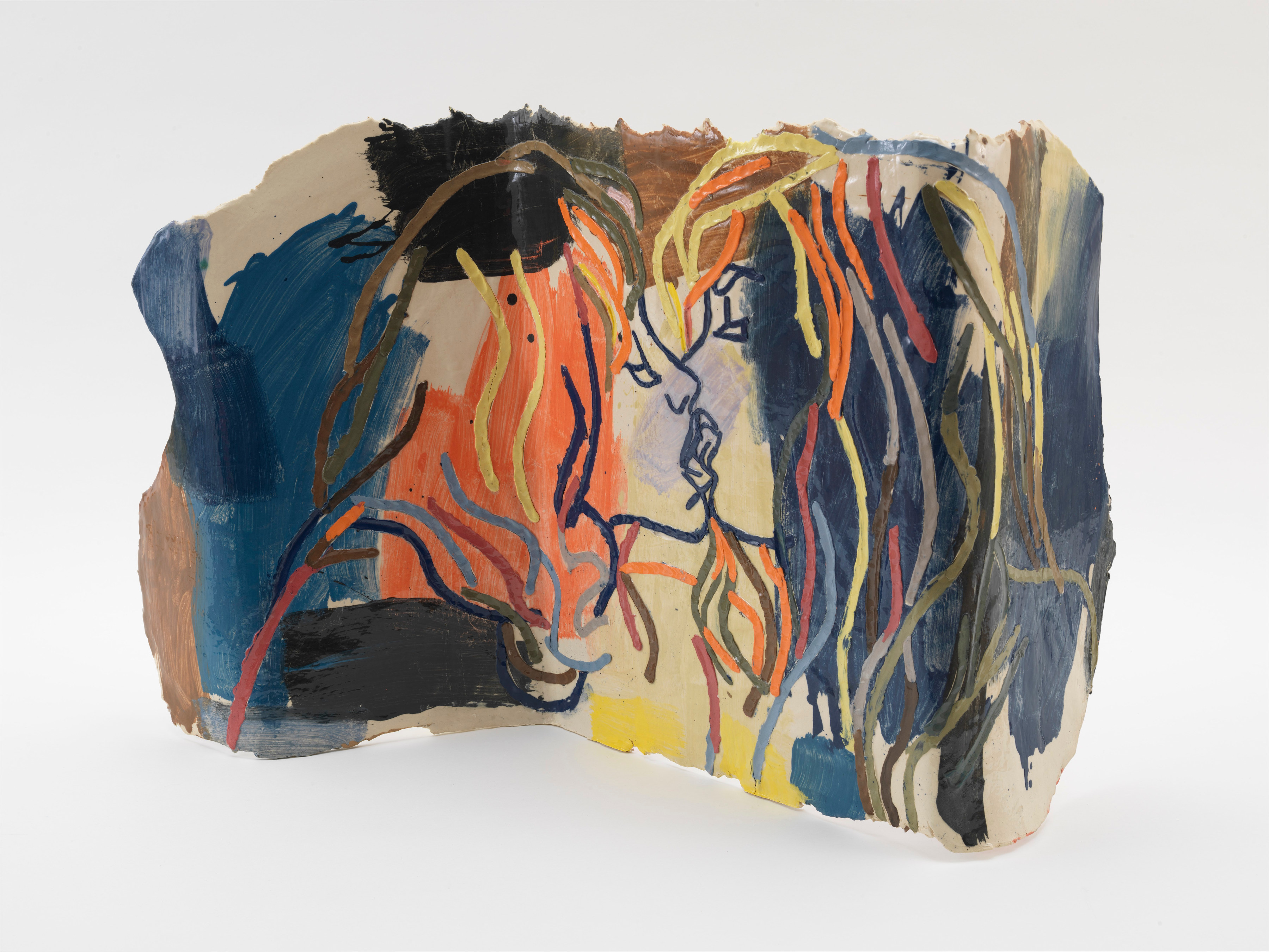
Ghada Amer
Paravent Avec Amour, 2015
Ceramic
59.7 x 73.7 x 27.9 cm
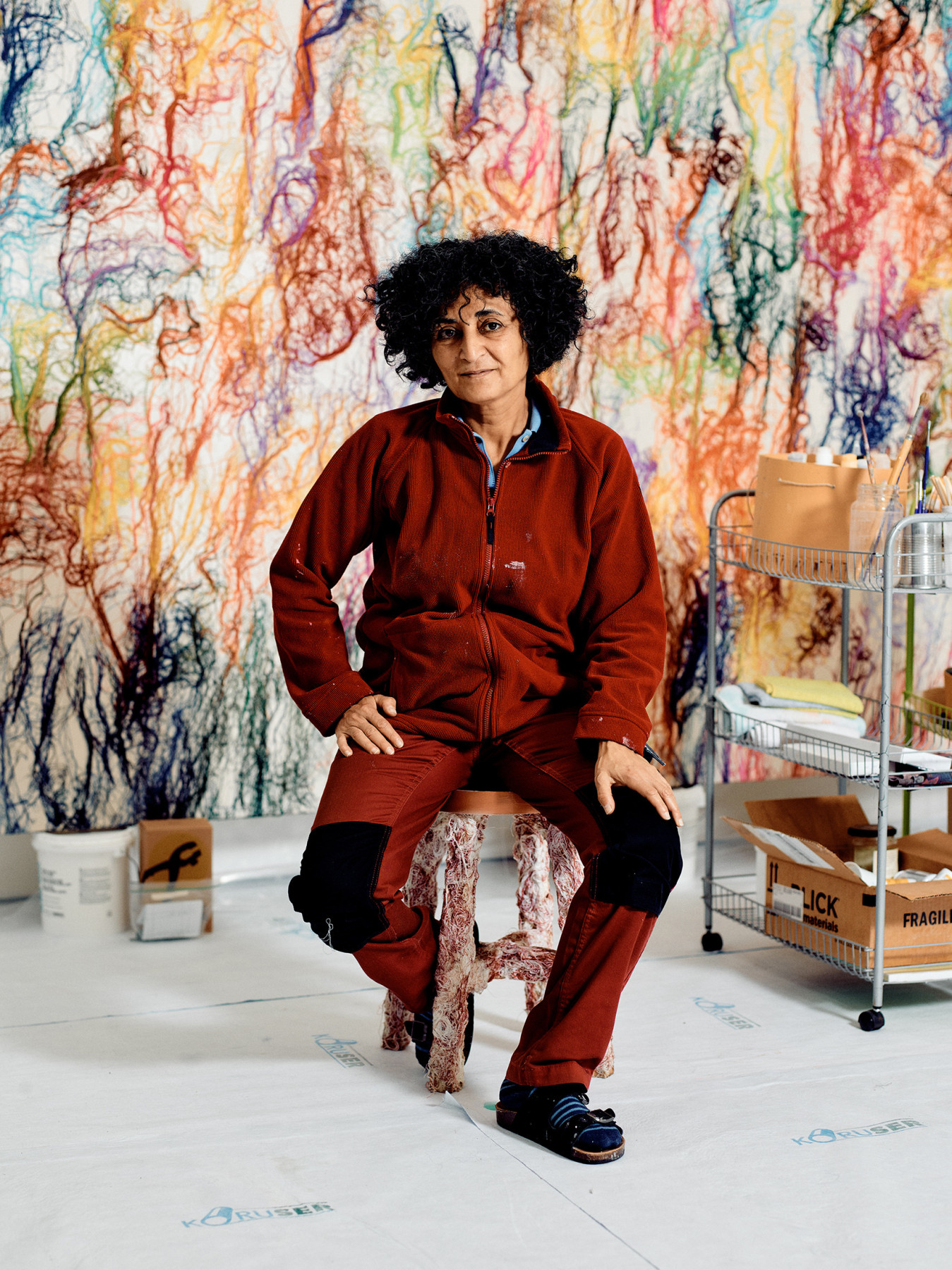
Ghada Amer was born in Cairo, Egypt in 1963 and moved to Nice, France when she was eleven years old. She remained in France to further her education and completed both of her undergraduate requirements and MFA at Villa Arson École Nationale Supérieure in Nice (1989), during which she also studied abroad at the School of the Museum of Fine Arts in Boston, Massachusetts in 1987. In 1991 she moved to Paris to complete a post-diploma at the Institut des Hautes Études en Arts Plastiques. Following early recognition in France, she was invited to the United States in 1996 for a residency at the University of North Carolina, Chapel Hill. She has since then been based in New York.
Amer’s wide-ranging practice spans painting, cast sculpture, ceramics, works on paper, and garden and mixed-media installations. Further, she often collaborates with her long-time friend Reza Farkhondeh. Recognising both that women are taught to model behaviors and traits shaped by others, and that art history and the history of painting in particular are shaped largely by expressions of masculinity, Amer’s work actively subverts these frameworks through both aesthetics and content. Her practice explores the complicated nature of identity as it is developed through cultural and religious norms as well as personal longings and understandings of the self.
Amer’s work is in public collections around the world including The Arab Museum of Modern Art, Doha; the Art Institute of Chicago, Chicago, IL; the Barjeel Art Foundation, Sharjah; the Brooklyn Museum of Art, New York, NY; Centre Georges Pompidou, Paris; Crystal Bridges Museum of American Art, Bentonville, AR; the Guggenheim Museum, Abu Dhabi; the Israel Museum, Jerusalem; the Samsung Museum, Seoul; among others. Among invitations to prestigious group shows and biennials—such as the Whitney Biennial in 2000 and the Venice Biennales of 1999 (where she won the UNESCO Prize), 2005 and 2007—she was given a midcareer retrospective at the Brooklyn Museum of Art in New York in 2008. Multiple institutions across Marseille, France are currently co-organising a retrospective for 2022 that will travel to the United States and Asia.

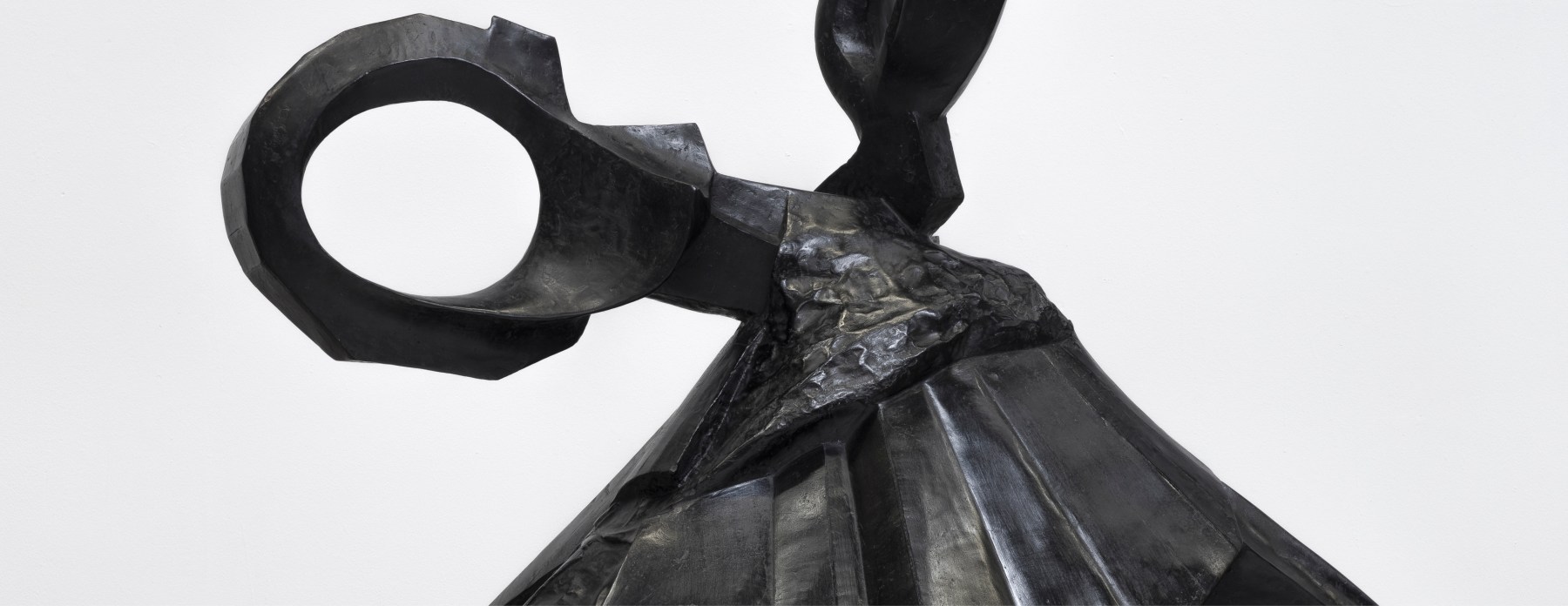
Cut, Her and Pour are part of Kentridge’s ongoing Lexicon series. Acting as a visual dictionary, the sculptures form a vocabulary of symbols, or ‘glyphs’, representing a collection of everyday objects, suggested words, or icons that are ubiquitous in the artist’s broader practice. Pour is the newest addition to this collection of bronzes.
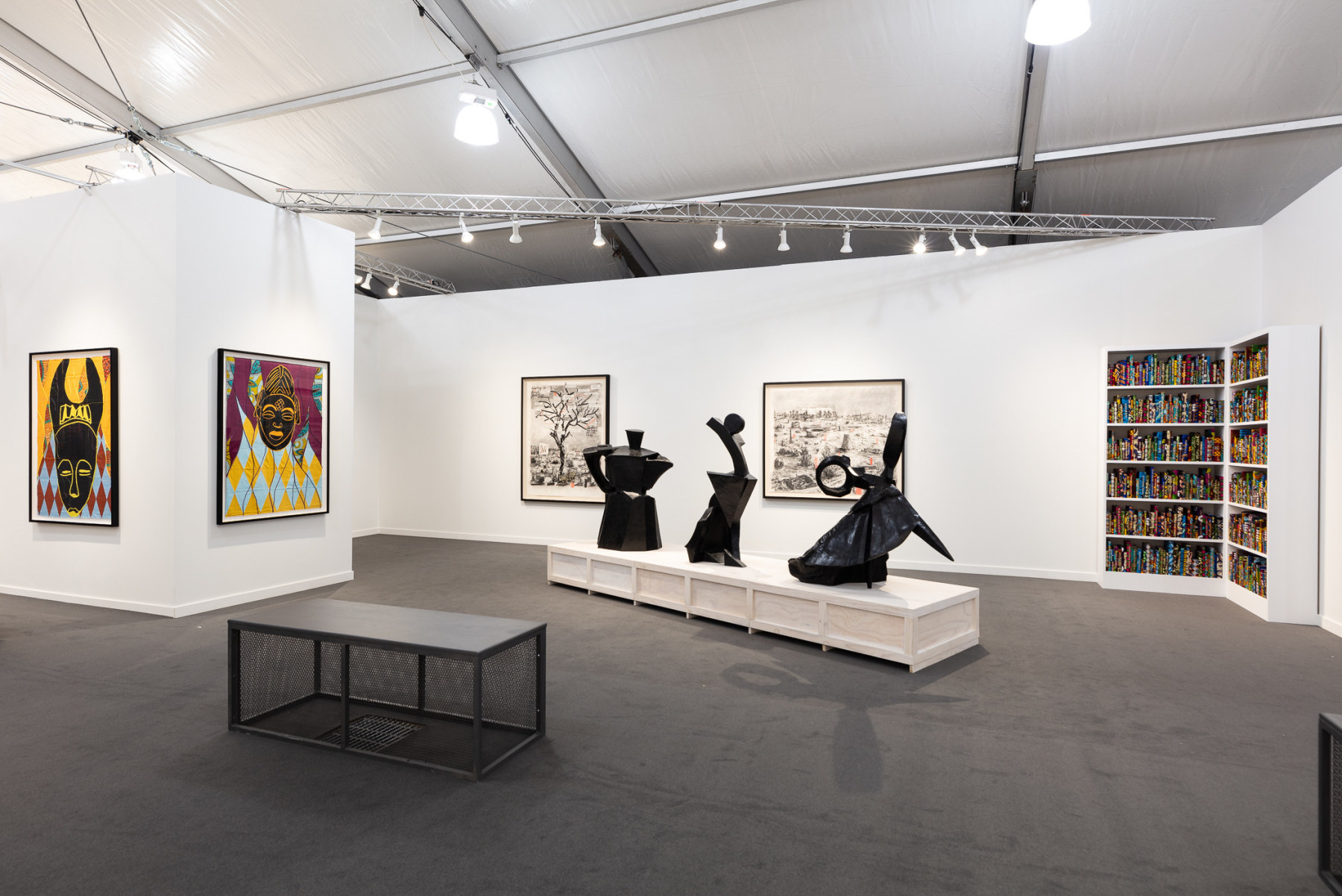
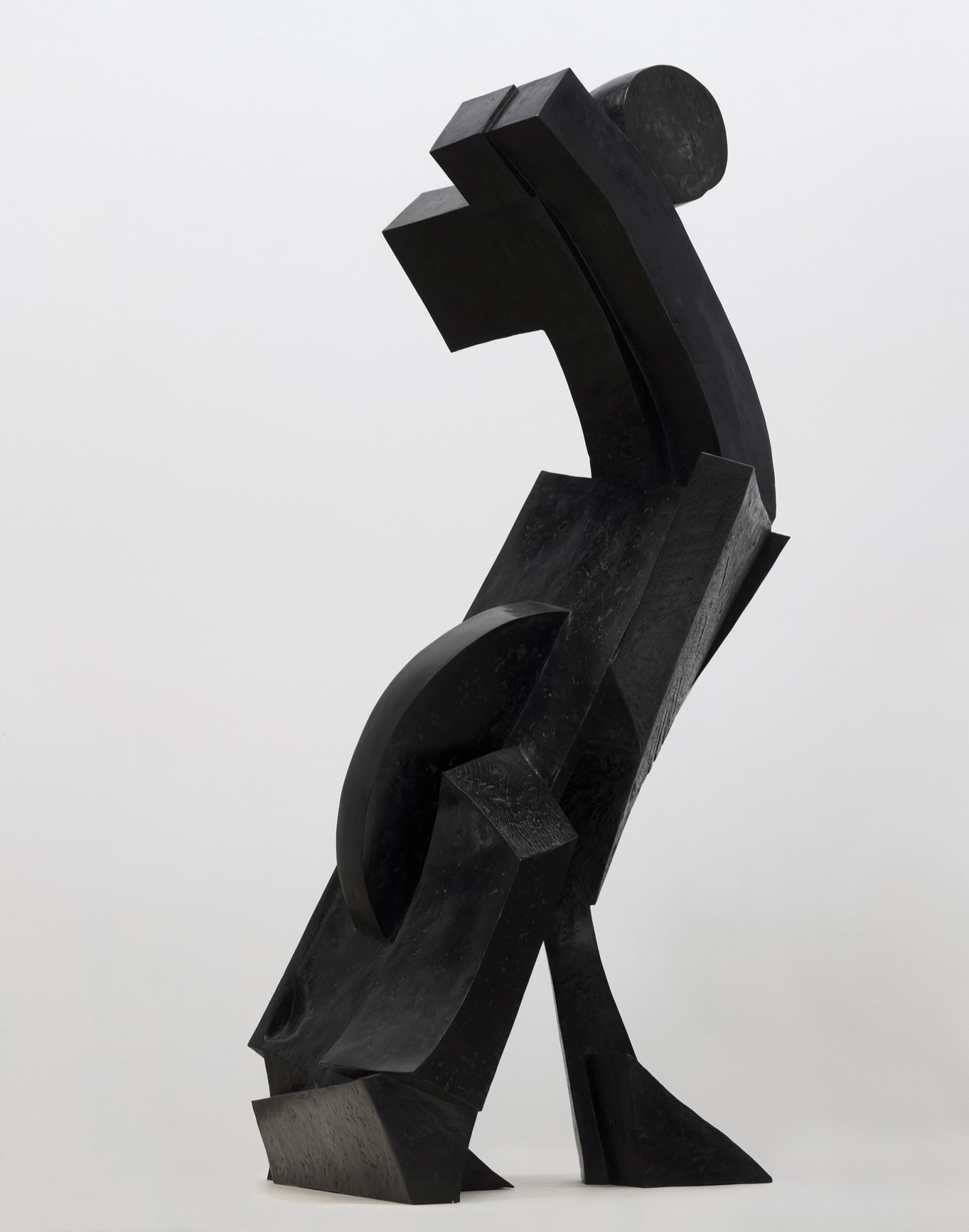
William Kentridge
Her, 2021
Bronze
Work: 134 x 60 x 46 cm
Weight : 136 kgs
STD 2/5
Edition of 5

William Kentridge
Cut, 2021
Bronze
Work: 134 x 85 x 135.5 cm
Weight : 214 kgs
STD 4/5
Edition of 5
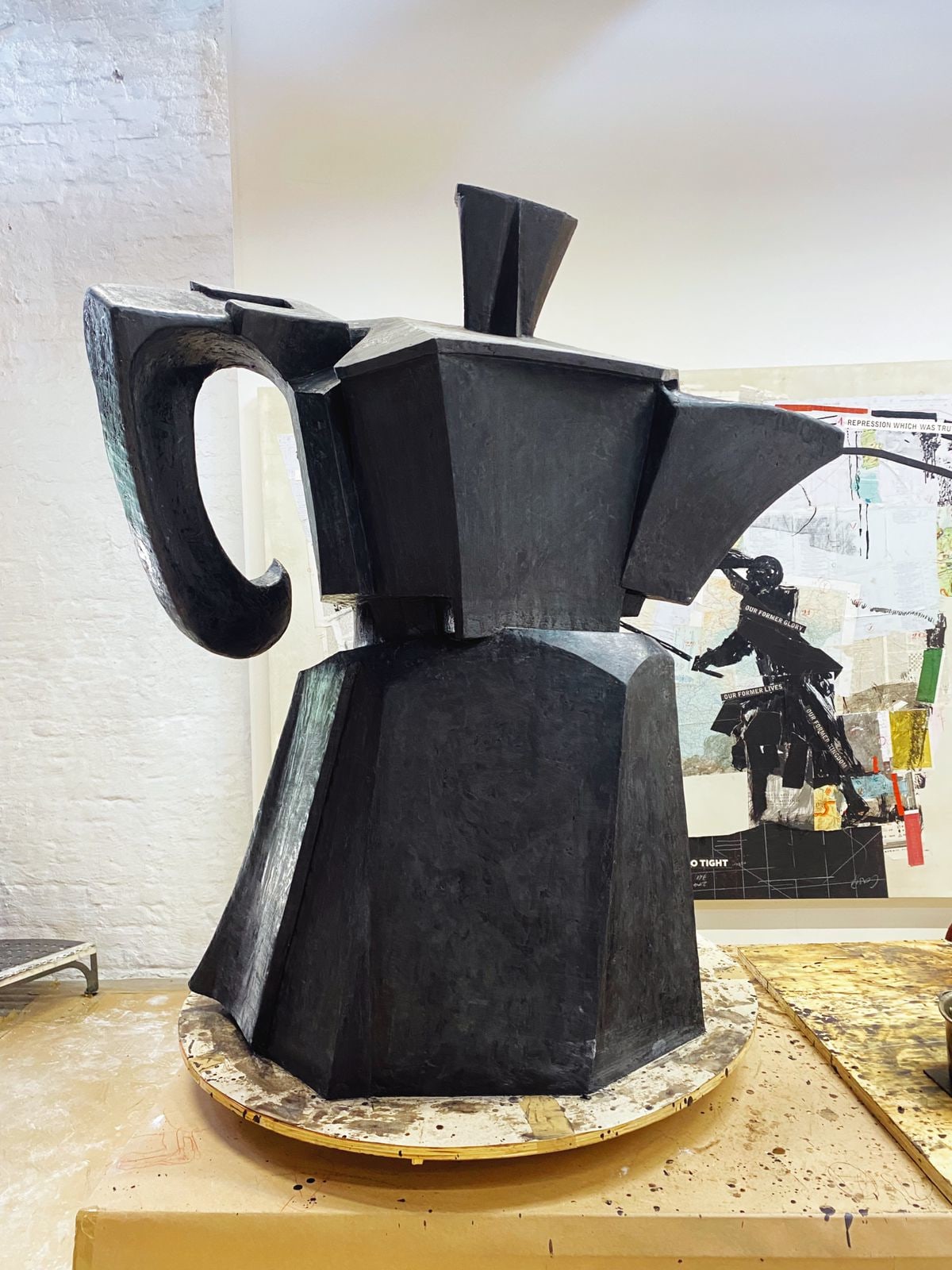
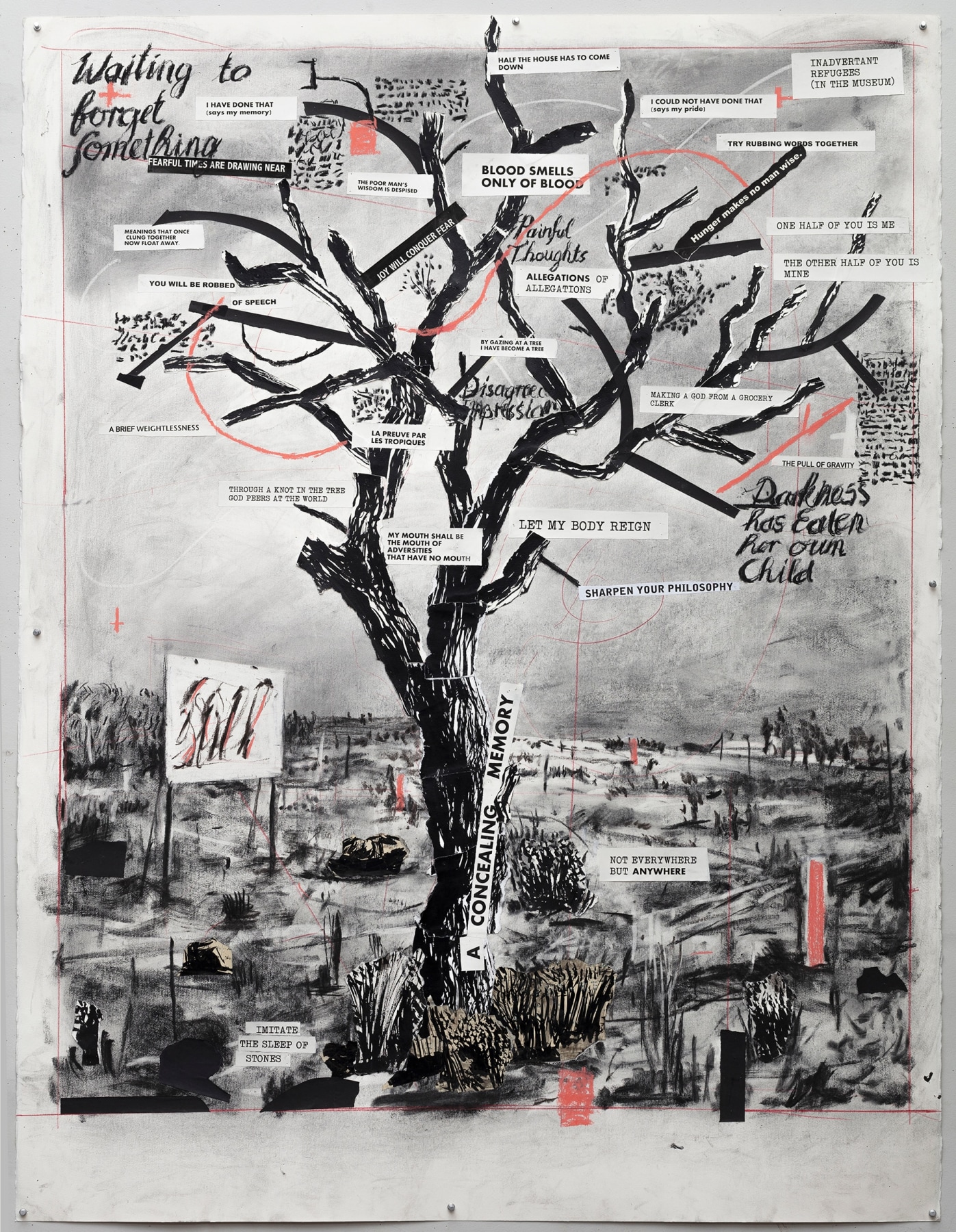
William Kentridge
Drawing for Self-Portrait as a Coffee Pot (Waiting to Forget Something), 2021
Velin Arches Blanc
Work: 160 x 121.5 cm
Unique
In March 2020, as the first COVID lockdown began in Johannesburg, Kentridge started working on a series of episodic films in his home studio. The series, now known as Self-Portrait as a Coffee Pot, have extended over the last three years in their construction becoming nine 40-minute films. Each episode explores the working processes in the studio, presenting different themes through which making happens. The first three episodes of Self-Portrait as a Coffee Pot premiered at the Toronto Film Festival, and the British Film Festival in 2022. Waiting for Something to Forget and Landscape are two significant drawings that were created through the filming process.
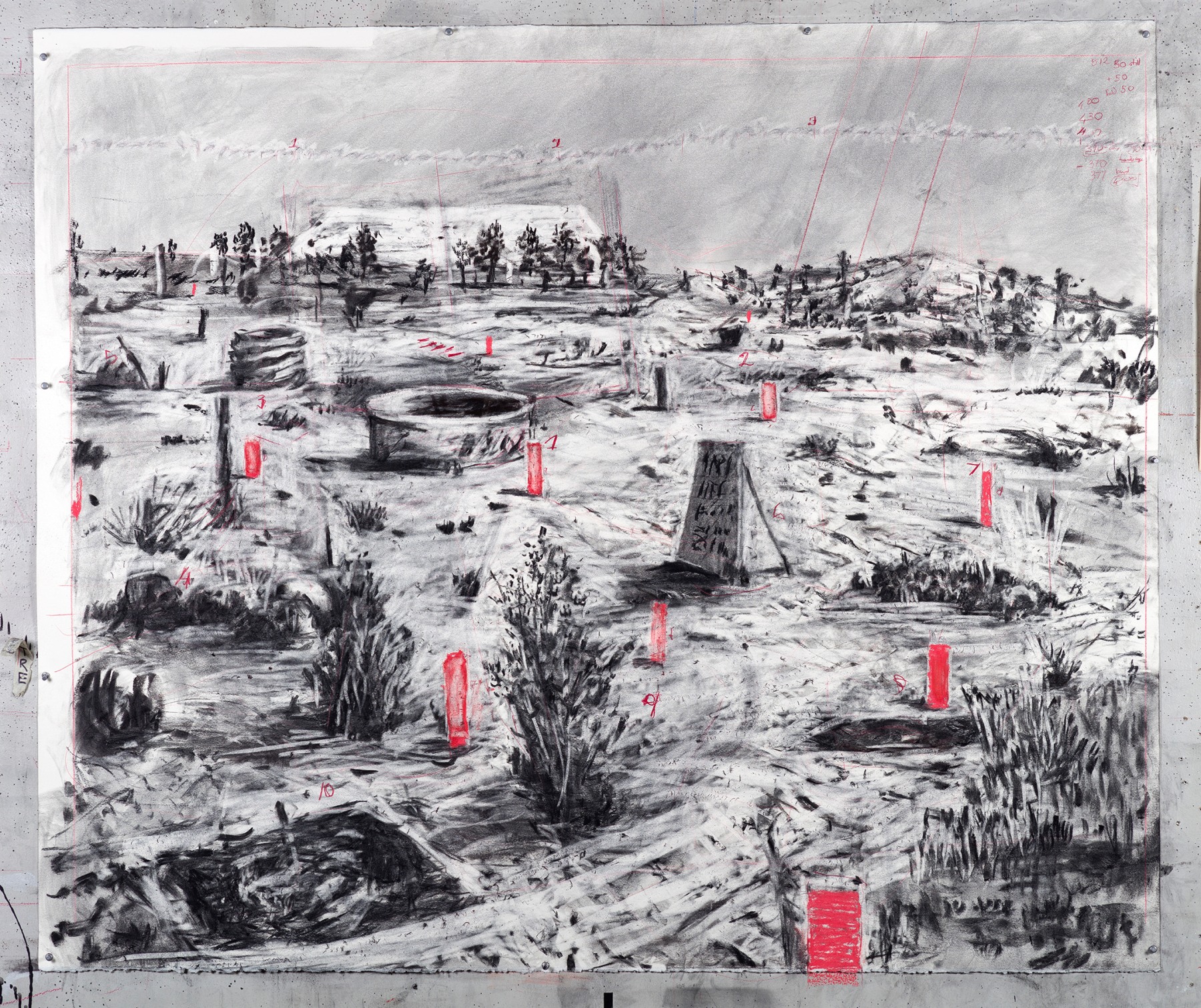
William Kentridge
Drawing for Self-Portrait as a Coffee Pot (Landscape), 2020
Charcoal, pastel and red pencil on paper
Work: 152 x 188 cm
Unique
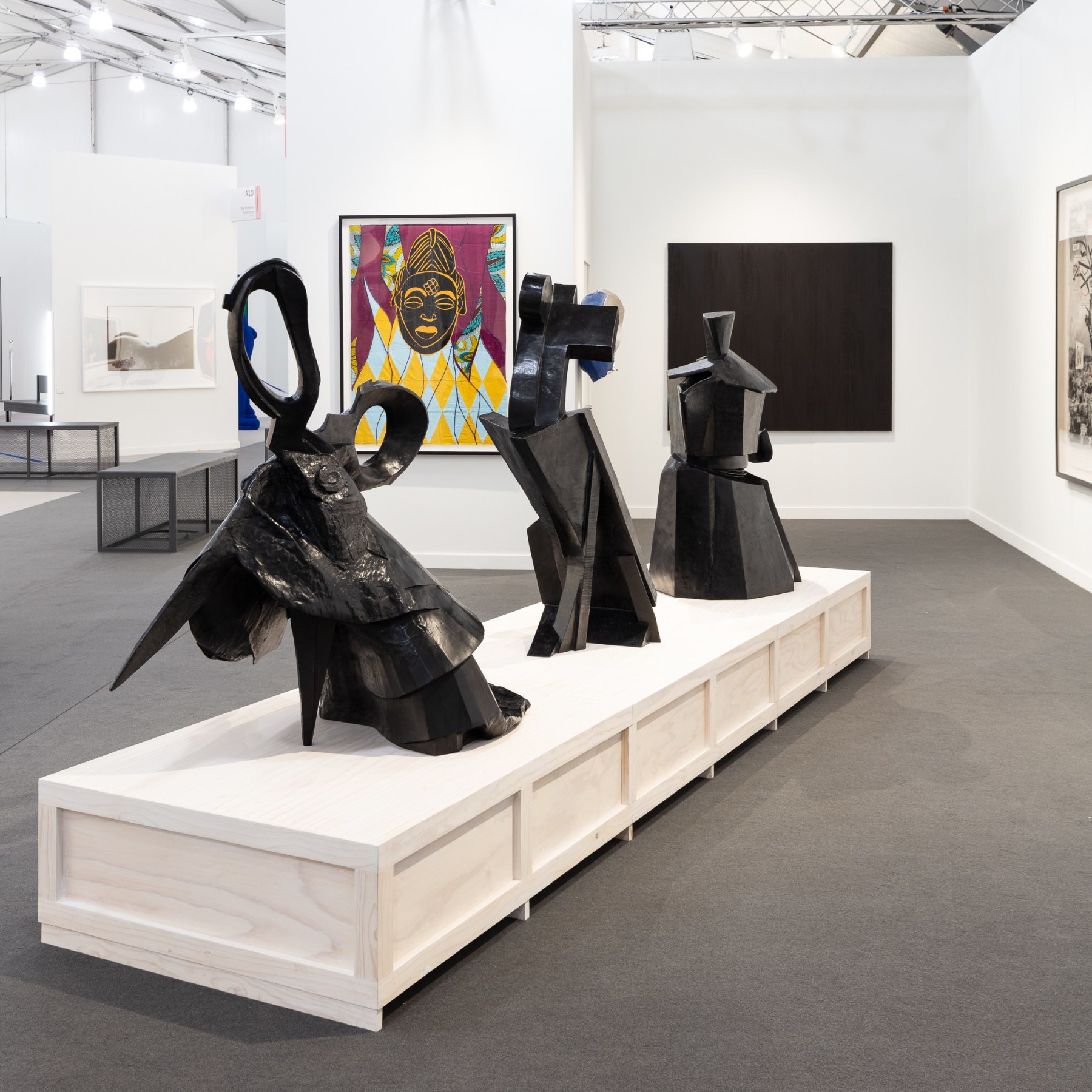
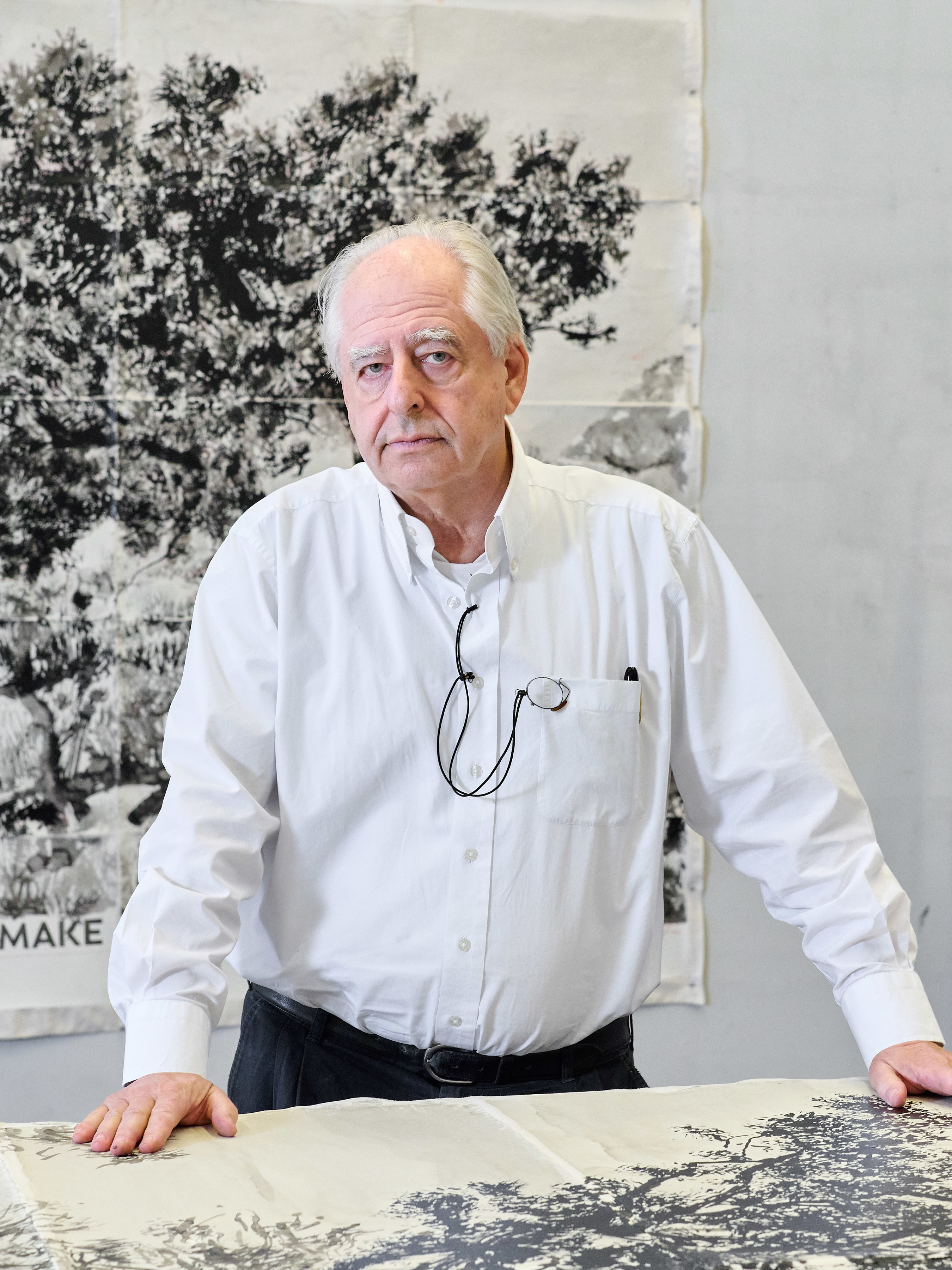
Kentridge is internationally acclaimed for his drawings, films, sculptures, theatre and opera productions. While his practice, expressionist in nature, is entirely underpinned by drawing, his method combines studio-based and collaborative practices to create works of art that are grounded in politics, science, literature and history, and maintain a space for contradiction and uncertainty.

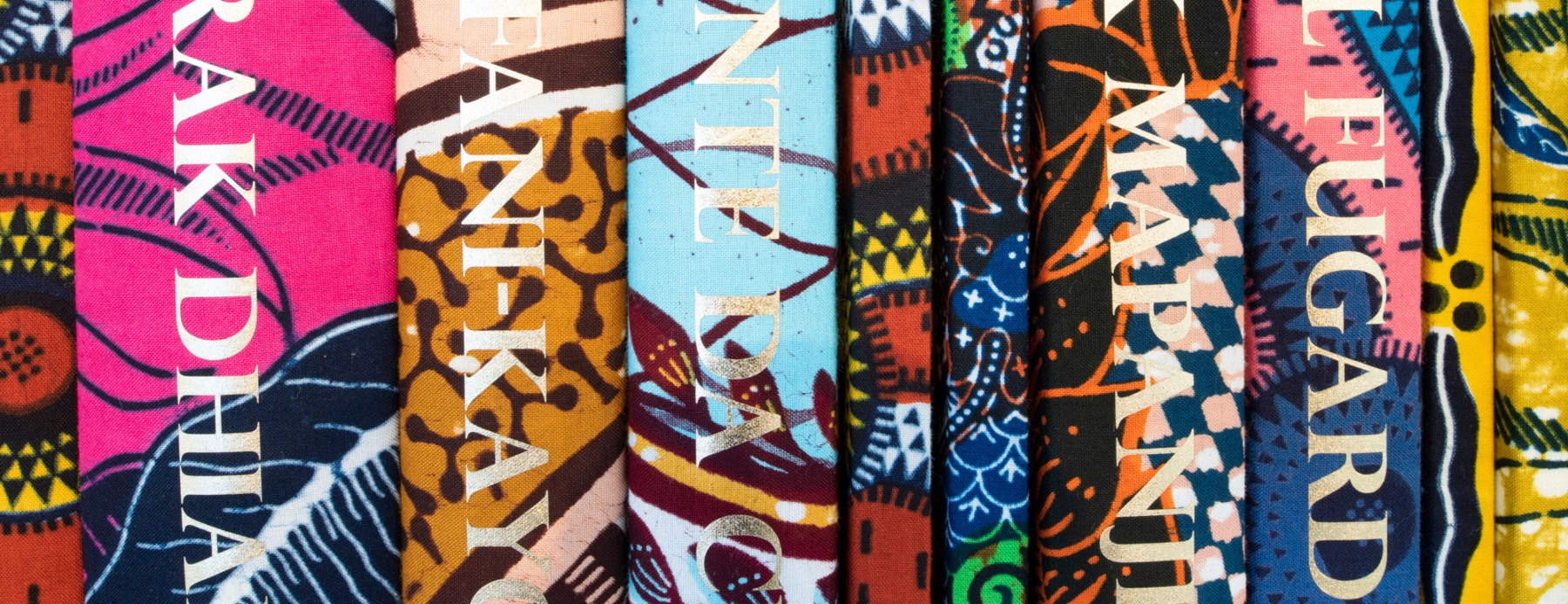

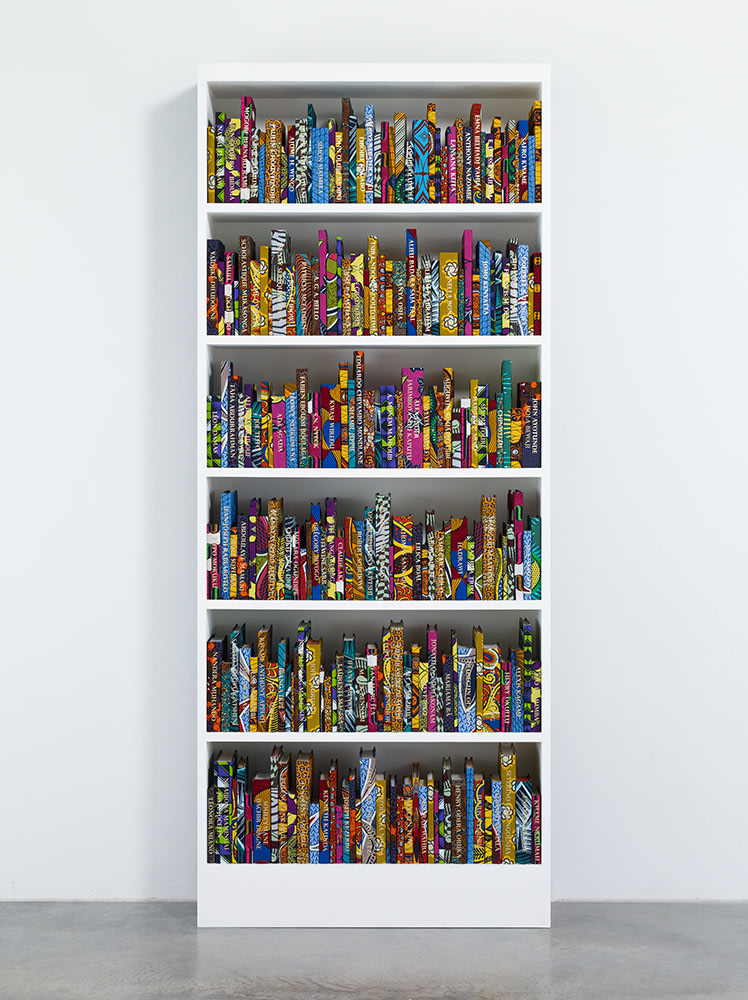
Yinka Shonibare CBE RA
The African Library Collection: Filmmakers and Theatre Practitioners, 2020
Work: 233.7 x 139.7 x 33.7 cm|
Unique
The African Library Collection by Yinka Shonibare consists of multiple books covered in the ‘Dutch wax print’ typical of the artist’s practice. The spines of many of these books are printed with the names of notable figures from the continent, from various categories including political figures, designers and filmmakers. The work is arranged on rows of shelving and accompanied by a bespoke card catalogue box. The collection commemorates the fight for independence in the European colonies across the African continent.

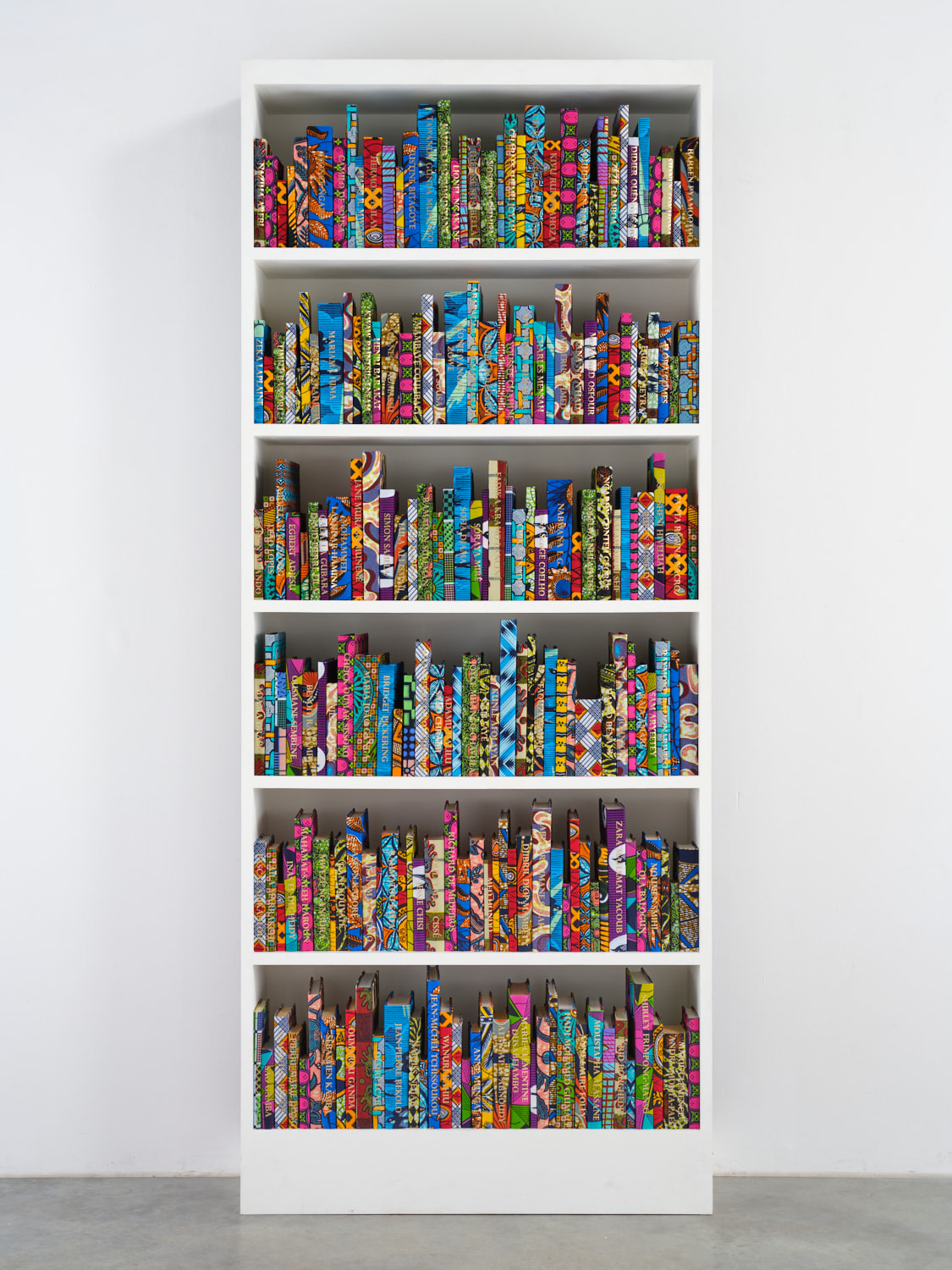
Yinka Shonibare CBE RA
The African Library Collection: Designers, 2020
Work: 233.7 x 139.7 x 33.7 cm
Unique
The use of ‘Dutch wax fabric’ in all iterations of this series speaks to the hybrid nature of national and cultural origins and the interdependence of the economic and political histories of Africa and Europe. The artist states “the fabrics are a signifier of the identity of people from Africa and the African diaspora, but more importantly, how they encounter with Europe. The textiles I use were actually produced by the Dutch and then sold to West Africans, yet they’re now known as markers of African identity. I’m very interested in the colonial relationship between Africa and Europe, and the fabrics have become a metaphor for that.”
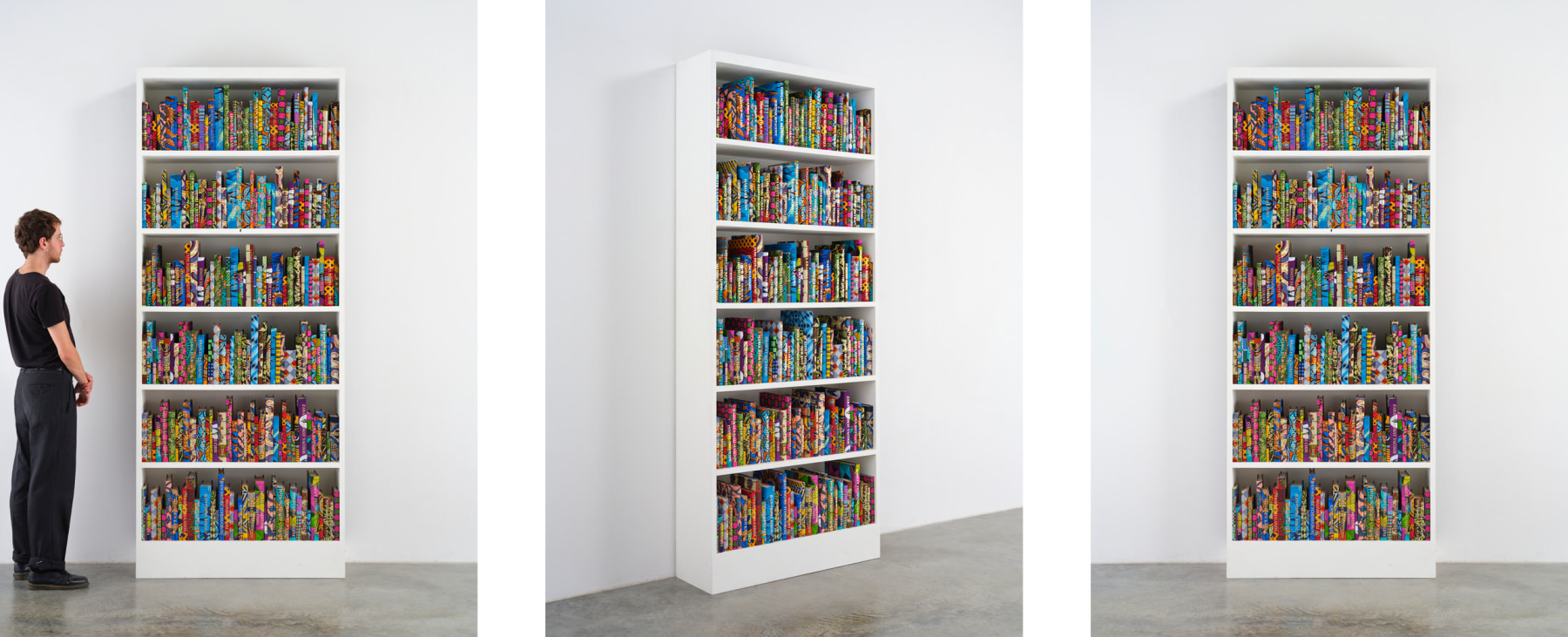

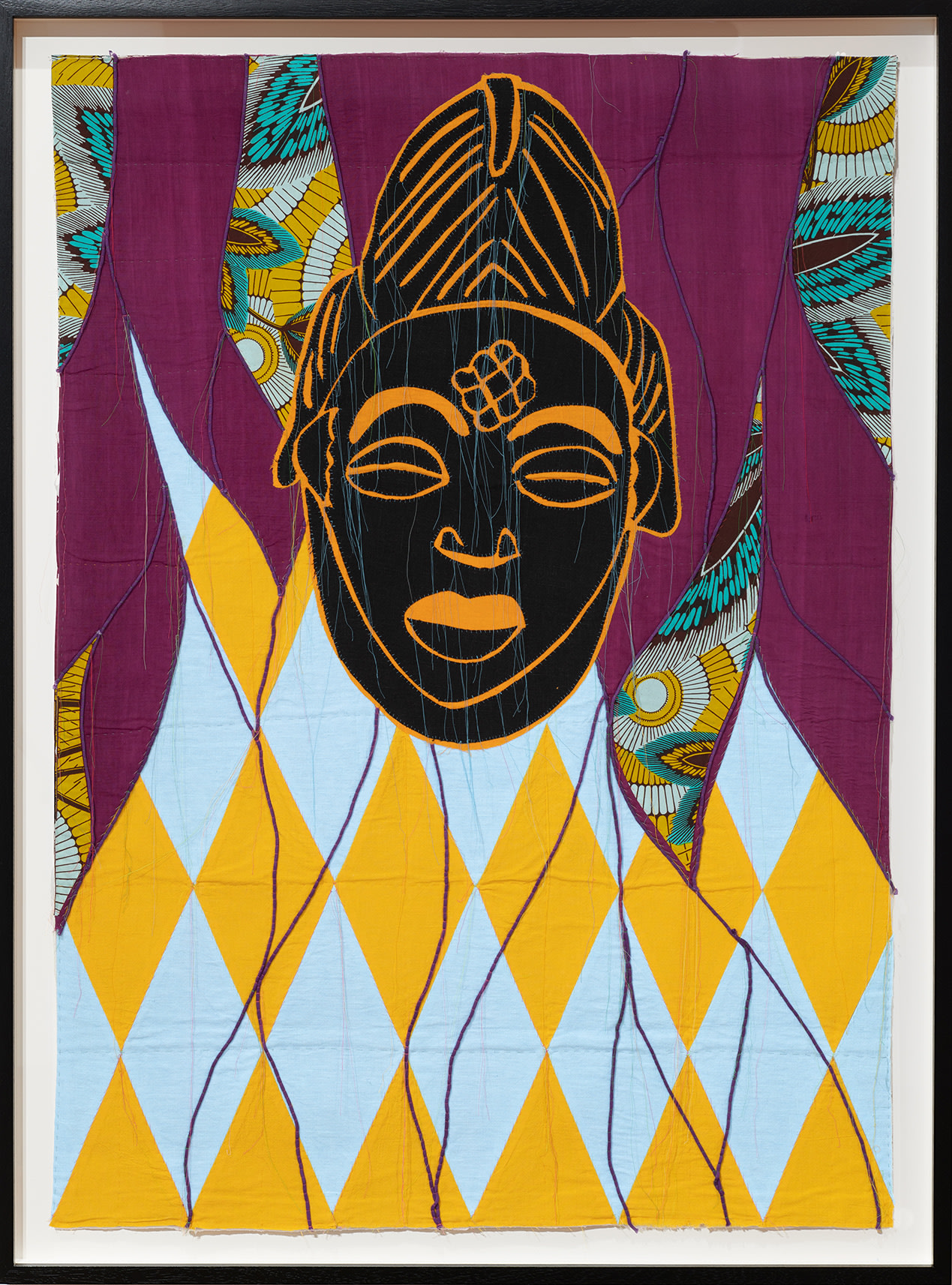
Yinka Shonibare CBE RA
Modern Magic VI, 2022
Patchwork, appliqué, embroidery and Dutch wax printed cotton textile.
140 x 100 cm
A series of vibrantly coloured, hand-stitched quilts illustrate African artefacts which formed part of the private collections of influential modernist artists such as Matisse and Derain. Classical European sculptures of goddesses drawn from Greek and Roman mythology are hand-painted with Shonibare’s signature Dutch wax batik patterns, their heads replaced with replicas of African masks complimentary to the figure’s associated myths. Each mask has been drawn from a prominent twentieth century artist’s collection.
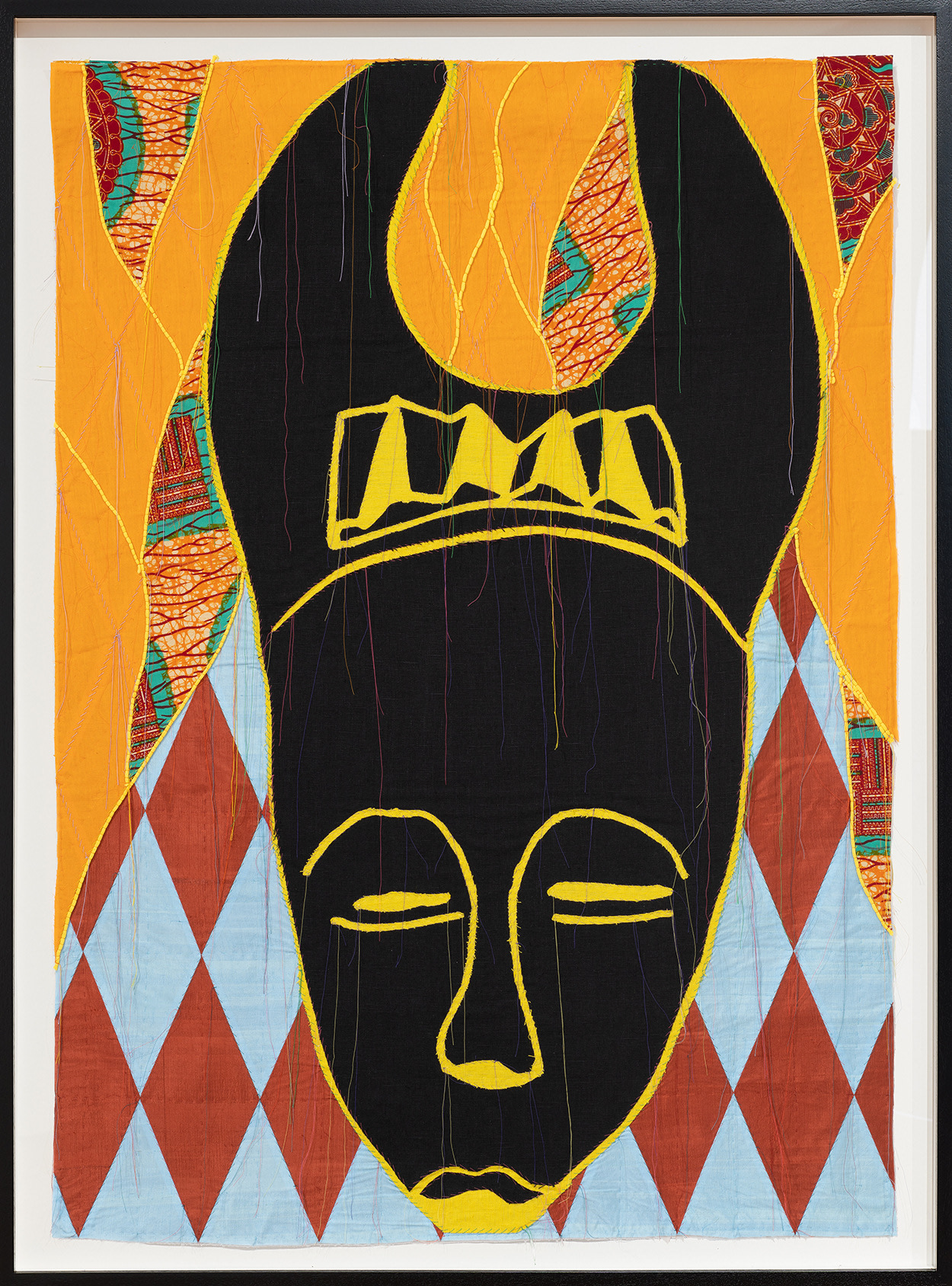
Yinka Shonibare CBE RA
Modern Magic VIII, 2022
Patchwork, appliqué, embroidery and Dutch wax printed cotton textile.
140 x 100 cm

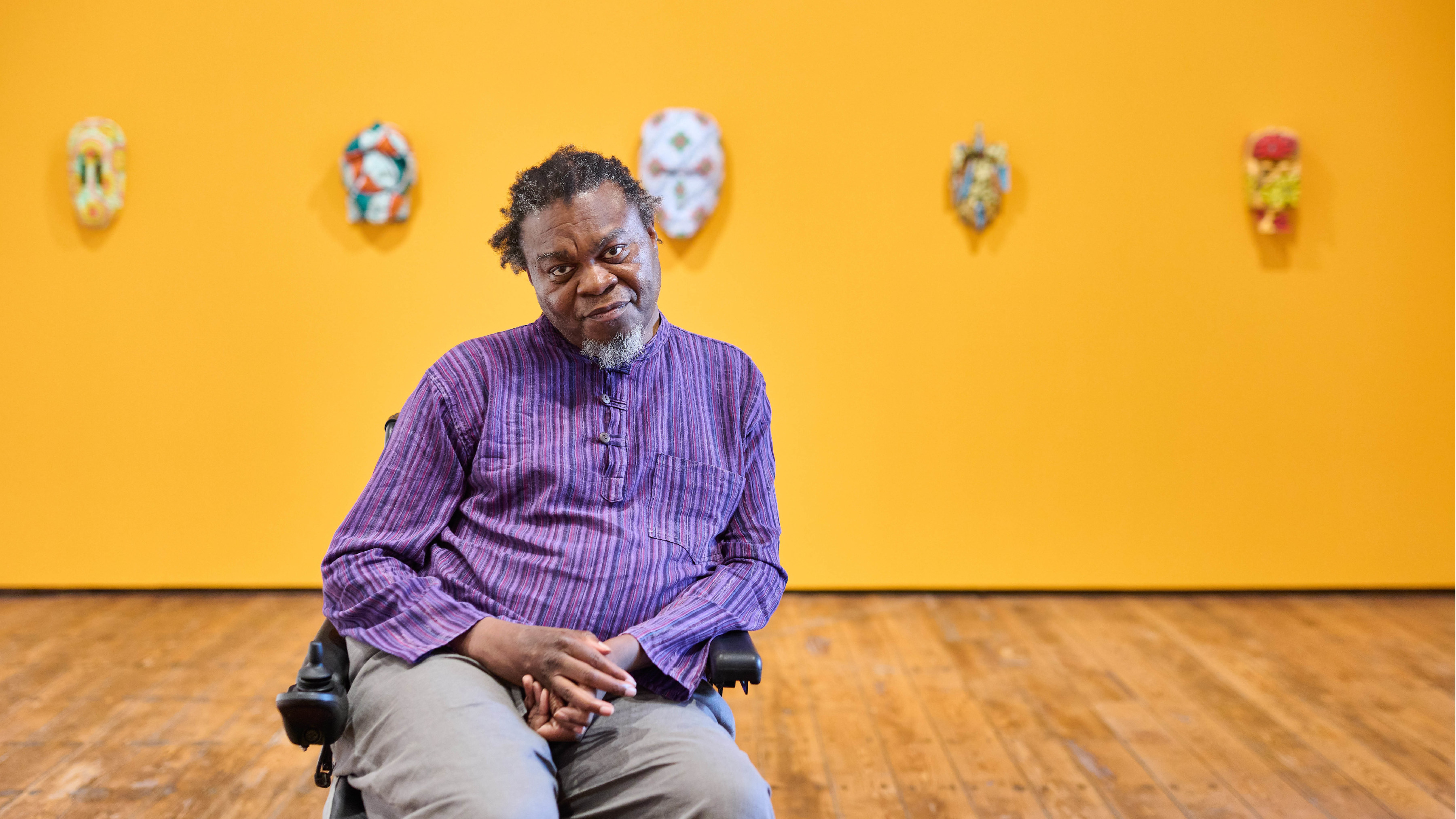
Yinka Shonibare CBE RA (b. London, UK, 1962) moved to Lagos, Nigeria at the age of three. He returned to the UK to study Fine Art at Byam Shaw School of Art, London and Goldsmiths College, London, where he received his Masters in Fine Art.
In 2022, Shonibare unveiled three major sculptural works in Stockholm, the United Kingdom and the United Arab Emirates. In recent years, he has unveiled Wind Sculptures at Norval Foundation in Cape Town (2019) and Central Park, New York (2018). Shonibare’s first public art commission, titled Nelson’s Ship in a Bottle, was displayed on the Fourth Plinth in Trafalgar Square in 2010 and was acquired by London’s National Maritime Museum.
Current and recent survey exhibitions and retrospectives include Yinka Shonibare CBE: Planets in My Head (1 April – 31 October 2022) at Frederik Meijer Gardens & Sculpture Park in Michigan and Yinka Shonibare CBE: End of Empire at the Museum der Moderne in Salzburg (22 May 2021 – 3 October 2021). Shonibare’s 2008 mid-career survey travelled from the Museum of Contemporary Art in Sydney to the Brooklyn Museum in New York as well as the Museum of African Art at the Smithsonian Institute in Washington D.C.
Major awards include the Whitechapel Gallery Art Icon Award 2021 and Shonibare was honoured as ‘Commander of the Order of the British Empire’ in 2019. Shonibare was also nominated for the Turner Prize in 2004, and in 2002, he created one of his most recognised installations, Gallantry and Criminal Conversation for Documenta XI.
Notable museum collections include: Zeitz MOCAA, Cape Town; Norval Foundation, Cape Town; Tate, London; the National Museum of African Art, Smithsonian Institute, Washington D.C; Museum of Modern Art, New York; Guggenheim Abu Dhabi; Moderna Museet, Stockholm and the Museum of Contemporary Art, Chicago.
